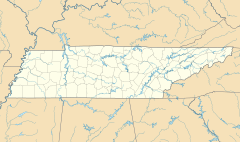Bearden, Knoxville facts for kids
Quick facts for kids
Bearden
Bearden Village
|
|
|---|---|

Kingston Pike through Bearden, as seen from Bearden Hill
|
|
| Country | United States |
| State | Tennessee |
| County | Knox |
| City | Knoxville |
| Elevation | 866 ft (264 m) |
| Time zone | UTC-5 (Eastern (EST)) |
| • Summer (DST) | UTC-4 (EDT) |
| ZIP code |
37919
|
| Area code(s) | 865 |
| GNIS feature ID | 1305023 |
Bearden, also called Bearden Village, is a neighborhood in Knoxville, Tennessee, United States. It's found along Kingston Pike in West Knoxville. Long ago, in the 1800s, it was mostly a farming area. Today, it's a busy center for shops and businesses in Knoxville. The neighborhood is named after Marcus De Lafayette Bearden (1830–1885), who was once the mayor of Knoxville. Bearden became part of Knoxville in 1962.
Contents
Where is Bearden?
Bearden is located along Kingston Pike, which is part of U.S. Route 70 and U.S. Route 11. It's about 5 miles (8 km) west of downtown Knoxville. The area usually called "Bearden" stretches along Kingston Pike. It runs between Lyons View Pike on the east and Sutherland Avenue on the west. Sometimes, people use "Bearden" to mean the whole Kingston Pike area. This larger area goes from Sequoyah Hills to Turkey Creek. Other neighborhoods nearby include West Hills to the northwest and Forest Heights to the north.
Bearden's Story
How Bearden Started
The area we now call Bearden began as a small community. It grew around a strong, protected house. This house was likely near where Kingston Pike and Northshore Drive meet today. At first, the community was known as "Erin." This name probably came from the many Irish settlers who lived there. In 1792, a surveyor named Charles McClung mapped out the "Kingston Road." This road was built to connect Knoxville with Campbell's Station, which is now Farragut. This road helped more people move to western Knox County.
In the late 1700s, the Bearden area was a challenging place to live. Early settlers faced dangers. For example, James Miller, one of the first settlers, was said to have been killed soon after he arrived. In 1793, during a time of conflict, a group of Chickamauga Cherokee and Creek people attacked Cavet's Station near Bearden. Even after these conflicts ended, the area could still be risky. In the early 1800s, a part of the Kingston Road west of Bearden was even nicknamed "Murderers' Hollow" because of the dangers there.
The 1800s in Bearden
In the early 1800s, businesses in Bearden mostly served travelers on the Kingston Road. There were inns run by people like Thomas Hudiburgh and John Gamble. In 1838, two Knoxville businessmen, Marcus De Lafayette Bearden (1799–1854) and Gideon Hazen, built a paper mill. It was located along Third Creek in the Middlebrook area. This mill gave Papermill Drive its name. It worked until 1886 when its dam broke.
In 1817, an Irish immigrant named John Reynolds bought land that is now Bearden Hill. He bought it from James White, who helped found Knoxville. Reynolds's son, Major Robert Reynolds, later owned the land. He built a house called Knollwood, which is still on top of the hill today. It overlooks Kingston Pike. During the Civil War, Knollwood was used by Confederate general James Longstreet. He stayed there while planning an attack on Knoxville.
Bearden's namesake, Marcus De Lafayette Bearden (1830–1885), was a different person. He was a relative of the paper mill founder. He was an officer in the Union Army, served as Mayor of Knoxville, and was a state lawmaker. He owned a farm in the community. In 1888, while he was a lawmaker, he helped get money for the Eastern State Hospital. This hospital, later called Lakeshore Mental Health Institute, was built on Lyons View Pike. It brought many jobs and helped the community grow.
Growing into a Shopping Hub
By 1900, Bearden was still a small, mostly farming community. It had a train station, a post office, a gristmill (for grinding grain), and two stores. But soon, more businesses started to open. This happened because Kingston Pike was on two important cross-country travel routes: the Dixie Highway and the Lee Highway. In the late 1920s, Knoxville's first motel, Edd's Tourist Camp, opened in Bearden. After that, many gas stations, motels, and restaurants appeared. They all served the tourists traveling on these highways.
In the 1960s, the new Interstate Highway System was built. This meant most long-distance travelers no longer used Kingston Pike. However, new shopping centers brought a big change. Western Plaza, Knoxville's first shopping center outside downtown, opened in 1957. Then, West Town Mall opened in the early 1970s. These new centers caused a huge growth in retail (shopping) in West Knoxville. Many more shopping centers and stores opened in the 1970s and 1980s. Because of this, Knoxville's main shopping area moved from downtown to West Knoxville.
Bearden's Economy Today
The Bearden area is now home to more than 30 shopping centers. These centers cover a huge amount of space. Besides West Town Mall, other big shopping areas include Homberg Place, Bearden Center, Knox Plaza, Papermill Plaza, and the Centre at Deane Hill. Most of these centers have one or two large main stores. They also have many smaller shops. Bearden also has dozens of office buildings.
Recently, Knoxville and the Bearden community have been working to make the area feel more like a friendly "village." They are building greenways (paths for walking and biking) and sidewalks. They are also changing rules to allow homes, shops, and offices to be mixed together. This helps create a more walkable and lively community.



